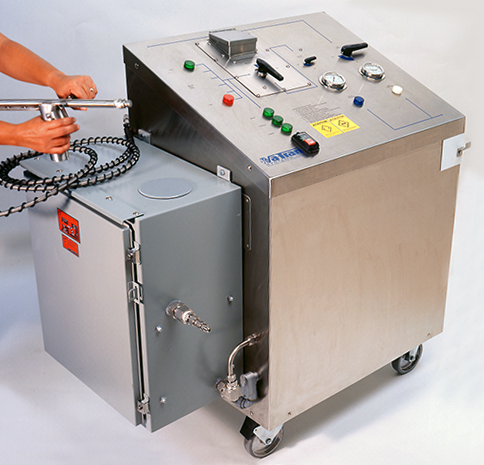Super Clean, Super Safe
Cleaning mechanical, electrical, and fluid components should not come at the cost of a protected environment. Unfortunately, traditional high-pressure cleaning systems for these components require the application of large quantities of solvents. The disposal of these solvents can cause environmental problems, especially Freon 113 and other chlorofluorocarbons (CFCs).
To address this problem, NASA's Kennedy Space Center developed an innovative system that makes cleaning super safe. Kennedy's Supersonic Gas/Liquid Cleaning System (SS-GLCS), which originated as a cleanliness verification tool for complex Space Shuttle mechanical and electronic parts, has commercial applications ranging from cleaning circuit boards to scouring building exteriors.
Kennedy's SS-GLCS has several advantages over other pressurized cleaning methods. The system does not abrade the surface of the hardware being cleaned, and it requires much lower levels of pressure while using very little water. These features enable the system to clean a wide variety of items. Developed as an alternative to CFC-based solvents, the system mixes air and water from separate pressurized tanks. It then ejects the gas-liquid mixture at supersonic speeds from a series of nozzles at the end of a hand-held wand. At these speeds, the water droplets have the kinetic energy to forcibly remove the contaminant material, dispersing it into a minimal waste stream. According to NASA lead project engineer, Raoul Caimi, "During our testing programs, we found that the gas-liquid supersonic system actually does a better job of cleaning than the system that uses CFCs." Since the environmentally friendly system requires less than 3 ounces of water per minute, there is very little fluid left after cleaning that must be handled as contaminated waste.
Taking advantage of the SS-GLCS' unique design, Va-Tran Systems of Chula Vista, California, is one of several companies to license Kennedy's invention for commercial application. Va-Tran is marketing the system as a tool to eliminate heavy hydrocarbon contamination. The company conducted studies that showed the product can also remove adhesive, flux, and fingerprints. According to Va-Tran, test results indicate that oil and grease can be removed with a greater than 95-percent efficiency.
Va-Tran's SS-GLCS can be applied in the aerospace, automotive, and medical industries, as well as to circuit boards, electronics, machinery, metals, plastics, and optics. With a nozzle that can be oriented in any direction, the system is adjustable to allow all sides of a part to be cleaned without reorientation. Designed for operator safety and comfort, it requires minimal training and is easily moved on built-in casters, despite its 450-pound weight.
Other companies that have licensed SS-GLCS have suggested additional applications in the nuclear, pharmaceutical, semiconductor, and chemical industries.

By injecting water mist into a supersonic stream of air, the Supersonic Gas/Liquid Cleaning System uses less pressure and water than other systems, decreasing leftover contaminated fluid as a result.













